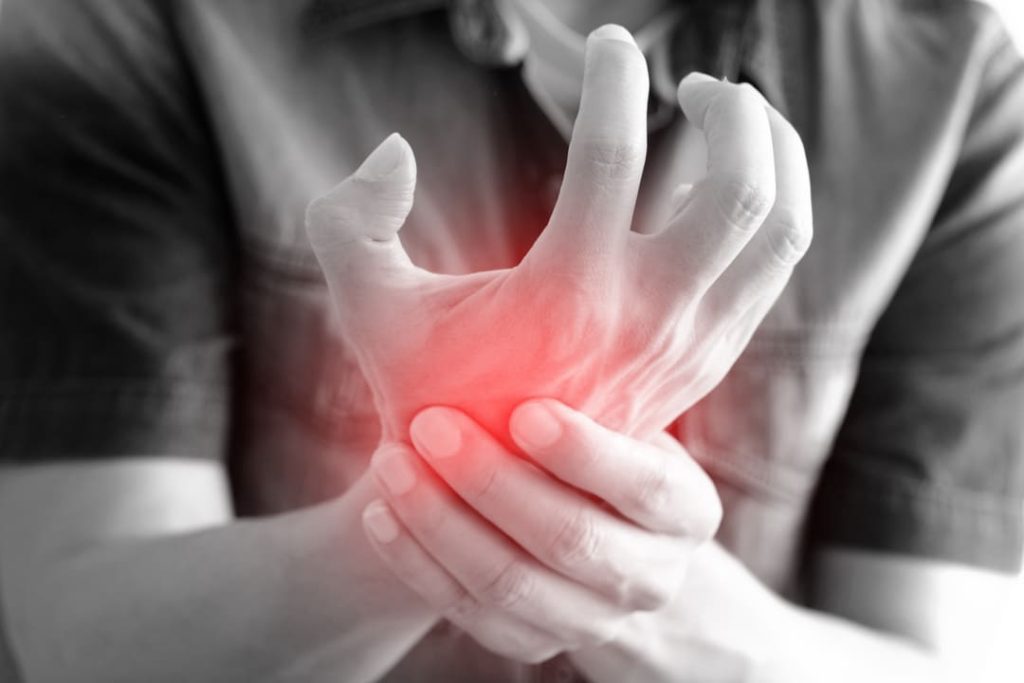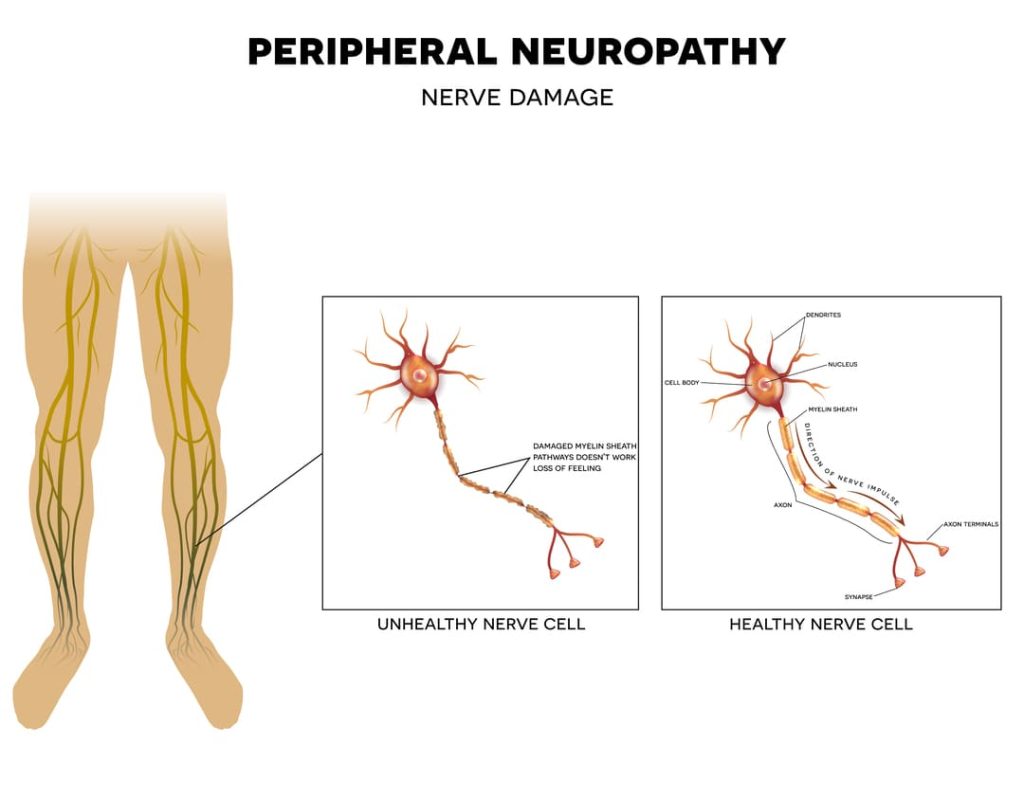Looking for Expert-Level VA Claim Answers?📱Call Us Now! 737-295-2226
Peripheral neuropathy, or nerve damage, can be a debilitating condition that significantly affects a veteran’s quality of life. For veterans, the symptoms of peripheral neuropathy can make it difficult to perform daily tasks and maintain their independence.
With over two million veterans living with this condition, it’s important to understand how to get the VA rating for peripheral neuropathy you deserve. This post will explore five ways to strengthen your claim and earn the highest VA rating for peripheral neuropathy.
Don’t let your disability control your life; take steps to get the care and compensation you’ve earned.
Table of Contents

Peripheral neuropathy is nerve damage to your peripheral nerves, which are the nerves that run through the body outside of the brain and spinal cord. These nerves transmit signals to and from the brain and spinal cord to the rest of the body, including the muscles, skin, and organs.
When these nerves are damaged or diseased, it can lead to various symptoms, including pain, numbness, tingling, and muscle weakness. This leads us to our first tip—Look for nerve damage symptoms.
Look for Symptoms of Peripheral Neuropathy
Symptoms of peripheral neuropathy can vary depending on the type and severity of the condition. Some common symptoms include:
- Pain or discomfort in the hands and feet
- Numbness or tingling in the hands and feet
- Weakness in the muscles of the hands and feet
- Loss of reflexes in the hands and feet
- Loss of sensation in the hands and feet
- Difficulty walking or balancing
- Burning or stinging sensations
- Loss of coordination
- Loss of sensitivity to touch, heat, or cold
If you’re experiencing one or more of these symptoms and haven’t been diagnosed, it’s time to see your doctor.
What causes peripheral neuropathy?
There are many causes of peripheral neuropathy, including diabetes, chemotherapy, certain medications, infections, and injuries. While neuropathy can be inherited through genetics, exposure to toxins, including heavy metals and chemicals, can significantly increase your chance of developing this condition, especially later in life.
Peripheral Neuropathy and Agent Orange
Unfortunately, peripheral neuropathy is a common condition among veterans, particularly those who served in Vietnam and were exposed to the herbicide Agent Orange.
Agent Orange contains a toxic chemical called dioxin, which is linked to many severe health conditions, including peripheral neuropathy. The good news is that if you have this type of exposure, it’s usually easier for you to earn a VA rating for peripheral neuropathy with a presumptive service connection (more on this below).

Peripheral Neuropathy VA Ratings
Usually, peripheral neuropathy VA ratings are either 10%, 20%, 30%, or 40%. However, you could earn a higher rating if your symptoms are severe enough.
VA disability ratings for veterans with peripheral neuropathy are based on the severity of the condition and its impact on your ability to work and function in daily life.
Diagnostic Codes for Neuropathy
Your VA rater will use a diagnostic code to assign you a VA rating for peripheral neuropathy. There is no single diagnostic code for peripheral neuropathy, which means you could be rated under one of the following codes:
- 8520 – Paralysis of the sciatic nerve
- 8521 – Paralysis of the common peroneal nerve
- 8530 – Paralysis of the Ilio-inguinal nerve
- 8620/8630 – Neuritis (nerve inflammation)
- 8720/8730 – Neuralgia (type of nerve pain caused by neuritis or neuropathy)
Neuritis, neuralgia, and neuropathy are terms often used interchangeably to describe nerve issues. However, neuropathy is physical nerve damage, while the other terms usually refer to pain or nerve inflammation.
A neuropathy VA rating is based on which nerve is being impacted. Many times, this involves the common peroneal nerve.
Here is how the VA rates for the common peroneal nerve (Diagnostic Code 8521):
- 40% rating for peripheral neuropathy – Complete paralysis of the nerve
- Complete loss of movement and feeling in the nerve that controls the foot
- Difficulty lifting the front part of your foot, and cannot bend your foot upwards
- Slight drooping of your toes and have lost the ability to spread your toes apart
- Lost the ability to move your foot sideways and have a weakened ability to move it in the opposite direction
- Complete loss of sensation on the top of your foot and toes
- 30% rating for peripheral neuropathy – Severe paralysis of the nerve
- You experience severe pain, tingling, and numbness, but the nerve isn’t completely paralyzed
- 20% rating for peripheral neuropathy – Moderate paralysis of the nerve
- You experience moderate pain, tingling, and numbness
- 10% rating for peripheral neuropathy – Mild paralysis of the nerve
- You experience mild pain, tingling, and numbness
If you experience symptoms in more than one limb, you could earn a separate rating for both limbs. You can use our VA disability rating calculator to combine these ratings to determine your total VA compensation for peripheral neuropathy.
Peripheral Neuropathy and the Bilateral Factor
If both sides of your body are impacted, ensure you’re aware of the bilateral factor. With this rule, when you have peripheral neuropathy that affects both your arms or legs, the VA will give you a higher rating than if it only affects one side. This is because it’s harder for you to do things when both sides are affected by peripheral neuropathy.
When you apply for a rating, the VA will give you a separate rating for each side. Then, they will add an extra 10% to these ratings before combining them with any other disability ratings.
Even if you have different types of disabilities on each side, you can still qualify for the bilateral factor.
You DESERVE a HIGHER VA rating. We CAN HELP.
Take advantage of a VA Claim Discovery Call with an experienced Team Member. Learn what you’ve been missing so you can FINALLY get the disability rating and compensation you’ve earned for your service.
How to Get a VA Rating for Peripheral Neuropathy
To get a VA rating for peripheral neuropathy, you must first prove that you have the condition and that it’s related to your military service.
You need to meet four criteria to get a VA rating for peripheral neuropathy:
- You have a current diagnosis of peripheral neuropathy (or nerve damage)
- You have medical evidence of peripheral neuropathy and its impact on your body, including your ability to work and function in daily life
- You experienced an event, injury, or illness that happened while you were serving that led to your peripheral neuropathy developing or getting worse
- You have a medical nexus, or link, that connects your peripheral neuropathy to your service event, injury, or illness

Get a Proper Diagnosis for Your Peripheral Neuropathy
A clear and detailed diagnosis of peripheral neuropathy from a qualified medical professional is essential to establish the condition’s existence. The diagnosis should include information about the type of peripheral neuropathy, the symptoms, and the cause of the condition.
There are several tests that your doctor may order to diagnose you with peripheral neuropathy. Some of the most common diagnostic tests include:
- Nerve conduction studies – This test measures the speed and strength of the nerve signals in your limbs. It can help to determine the extent of your peripheral neuropathy and the type of peripheral neuropathy you have. An example is Electromyography (EMG), which measures the electrical activity of your muscles.
- MRI – An MRI or other imaging test can help detect any structural problems causing your peripheral neuropathy.
- Nerve or skin biopsy – A small sample may be taken to look for abnormalities or reductions in nerve endings.
- Blood tests – Certain blood tests such as Vitamin B12 levels, glucose, and thyroid function tests may be ordered to rule out other causes of peripheral neuropathy.
Gather Evidence
The following types of medical evidence can help win a VA rating for peripheral neuropathy:
- Your medical diagnosis
- Medical treatment records – A thorough record of all the treatments you’ve received for peripheral neuropathy, including medications, therapies, and procedures, can help establish your condition’s severity.
- Neurological examination reports – A neurological examination report from a qualified medical professional can provide valuable information about the extent of your peripheral neuropathy, including the location and severity of your symptoms, any muscle weakness or reflex changes, and the results of any nerve conduction studies or other diagnostic tests.
- Statements from your doctors – Statements from your treating doctors about the impact of your peripheral neuropathy on your ability to work and function in daily life can provide valuable information about how your condition affects your quality of life.
- Service records – Service records that show your military service, including any potential exposure to toxins such as Agent Orange, can help to establish service connection for your peripheral neuropathy.
There are several different ways to establish service connection for peripheral neuropathy.
Prove Service Connection
You can prove service connection for peripheral neuropathy through primary, presumptive, or secondary connection.
Primary Service Connection
A medical nexus will be critical in proving service connection if you don’t qualify for presumptive or secondary service connection. This medical opinion will help meet the VA’s threshold of “more likely than not” that your military service caused or aggravated your peripheral neuropathy.
Presumptive Service Connection
Peripheral neuropathy can also be considered a presumptive condition for veterans who served in certain areas or during specific periods, such as those who served in Vietnam and were exposed to Agent Orange. In these cases, the VA presumes that your peripheral neuropathy is related to your military service and doesn’t require additional evidence of service connection.
However, you need to have symptoms that developed within one year of your discharge that were at least 10% disabling. Even if you didn’t have a proper diagnosis, it’s possible to show that you, more likely than not, were experiencing symptoms of peripheral neuropathy at the time through your medical records.
Secondary Service Connection
Secondary service connection for peripheral neuropathy is when your peripheral neuropathy isn’t not directly related to your military service but is a result of another service-connected condition.
In other words, it means that you have a different disability that’s service-connected, and this condition has caused your peripheral neuropathy.
Here are some examples of common secondary service connections for peripheral neuropathy:
- Diabetes – If you have service-connected diabetes, this could lead to peripheral neuropathy as a complication.
- Back Injury – You could develop peripheral neuropathy due to a service-connected back injury.
- Prostate Cancer – You could develop peripheral neuropathy as a result of your cancer or cancer treatment
To establish a secondary service connection for peripheral neuropathy, provide evidence to show that your peripheral neuropathy is caused by your service-connected condition. This may include medical reports linking your peripheral neuropathy to the other condition.
Prepare for Your C&P Exam for Peripheral Neuropathy
A VA Compensation & Pension (C&P) exam is an important step in obtaining a VA rating for peripheral neuropathy. A VA physician conducts the C&P exam to evaluate the severity of your condition and its impact on your ability to work and function in daily life.
Here is what you can expect during your VA C&P exam for peripheral neuropathy.
Your VA provider will complete a Disability Benefits Questionnaire (DBQ) For Peripheral Nerves during your exam. Looking at this form ahead of time can help you understand what your examiner is looking for and increase your chances of earning a higher peripheral neuropathy VA disability rating.
During the exam, your provider will ask you questions and perform a physical examination to answer the following questions on the DBQ form:
- Relevant medical records or service treatment records
- Diagnosis of your peripheral neuropathy
- The history of your peripheral neuropathy
- Symptoms you experience for each limb, ranked as mild, moderate, or severe
- Muscle strength testing rated from normal strength to no muscle movement for:
- How you can bend your elbow and wrist
- Grip
- Pinch (thumb to index finger)
- Knee extension
- Ankle movement
- Whether or not you have muscle atrophy and where, with measurements
- A deep tendon reflex exam
- A sensory exam testing sensation for light touch
- Abnormalities in the skin or tissue, including
- Changes in how the hair grows
- Changes in your nails
- Skin changes
- If your gait is normal or not, and a description of how it’s abnormal, if relevant
- Special tests for the median nerve (in your arm)
The VA will use the results from this form to assign you a neuropathy VA rating, so make sure to explain the symptoms you experience on your worst day.
Don’t Wait. Get The Support You Earned
A VA rating for peripheral neuropathy can help you get the care and compensation you deserve to manage your condition and improve your overall well-being.
Remember, you deserve the best care and support for serving our country and obtaining a peripheral neuropathy VA rating is one step toward that goal.

NEED MORE ASSISTANCE?
Most veterans are underrated for their disabilities and, therefore, not getting their due compensation. At VA Claims Insider, we help you understand and take control of the claims process, so you can get the rating and compensation you’re owed by law.
Our process takes the guesswork out of filing a VA disability claim and supports you every step of the way in building a fully-developed claim (FDC)—so you can increase your rating FAST!
If you’ve filed your VA disability claim and have been denied or have received a low rating—or you’re unsure how to get started—reach out to us! Take advantage of a FREE VA Claim Discovery Call. Learn what you’ve been missing—so you can FINALLY get the disability rating and compensation YOU DESERVE!

Trisha Penrod
Trisha Penrod is a former active-duty Air Force officer. As an Intelligence Officer, she led teams of analysts to apply advanced analytic skills to identify, assess, and report potential threats to U.S. forces.
Trisha attended the U.S. Air Force Academy and holds an MBA from Webster University. After receiving an honorable discharge in 2018, Trisha worked as a growth marketer and utilizes her analytic skills to help others accomplish their business goals.



